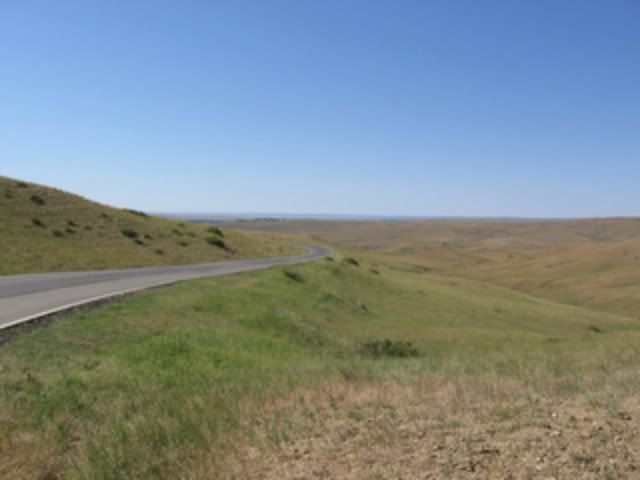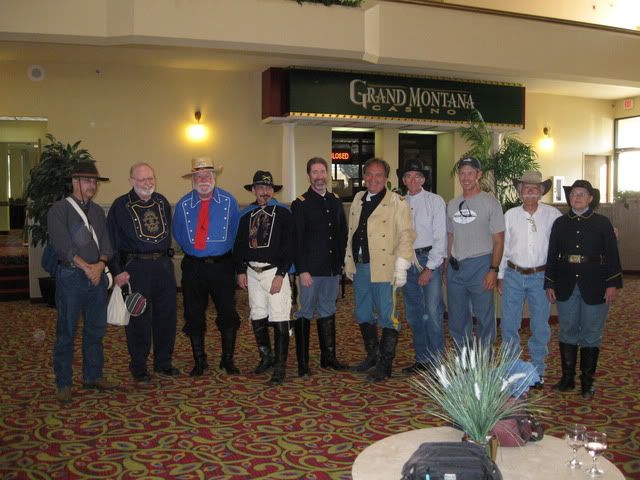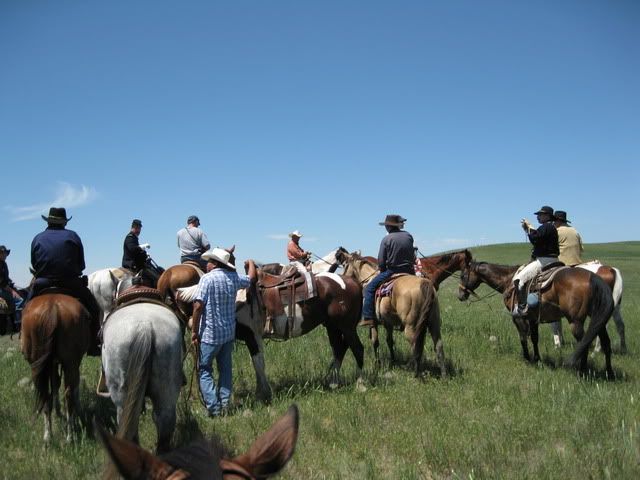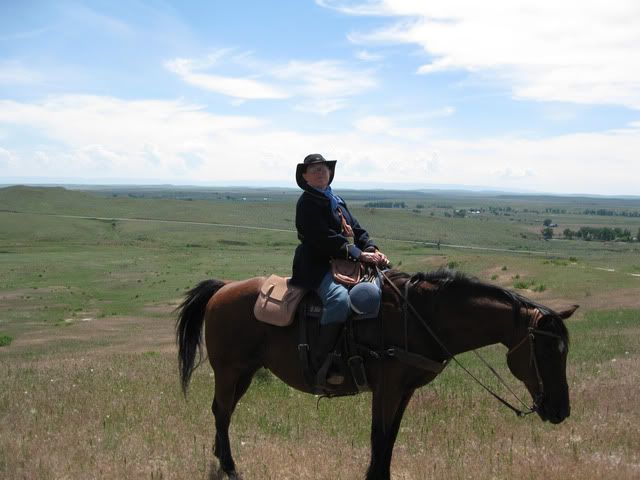|
|
Post by tbw on Mar 2, 2010 14:13:39 GMT -5
I know one of our members plans on riding the Little Big Horn again in the not too distant future. I guess what I would like to know is if anyone has ever done any horseback riding in that area, and if so what was their expierences with those rides. For me, it would be most difficult to get on a "led" tour and not be able to cut loose and do some real testing of how fast or slow some of those gaits could have been, of course without the road(s), and one simply cannot do that while on a tour horse. It's been a desire of mine for a long time, although I don't know whether such permission from some of the landowners could be acquired to do such a thing, it still would be interesting all the same.
|
|
|
|
Post by joewiggs on Mar 4, 2010 21:42:27 GMT -5
I agree Dennis. It would be great to actually ride the terrain involved and personally judge the ruts, crevasses, and pot holes that the soldiers actually endured during their run. It would tell us a great deal about the movements on the actual battle ground
In addition, I would appreciate an opportunity to view Calhoun Hill from Weir's point. One could better judge what was possible to see that evening.
|
|
|
|
Post by tbw on Mar 5, 2010 12:37:05 GMT -5
Calhoun is clearly in sight! And so too is Monument Hill and the whole of Battle Ridge. It's almost 2 miles across the valley in a direct line of sight. Cars do seem to be a bit small over there, but are clearly discernable. I don't know how strong their field glasses were back in those days but even at a small power they could have picked out individual soldiers at that distance.
What i'm more concerned with when it comes to "the ride", is the truth, than I am with the math. Sure anyone can do math and come up with 1001 reasonings for different gait speeds. But one thing I did observe the last time I was there, was the "gully system" that ran off of those bluffs as they descended from the Divide. I am quite confident that the Indians had worn a well beaten trail through there. But, at some point, so we are told, the men were told to stay off of that trail because of the dust. It would be next to impossible to navigate those deep gullies, at a maintained speed, without some kind of road. This interests me still to this day, because we have alot of people saying that Custer went down this stream (Reno Creek) at a terrific gait rate. With all those intervening gullies was this even possible with over 600 men? And, if so, would they be able to maintain any kind of cohesive unit? I personally don't think so.
Sure today we can go up and down that road, but take that darn road out of there and what have you? Just exactly what they had! Less the well worn dust ridden Indian trail, of course. And whose to say how wide that those would have been when going through those deep gullies? I still tend to favor John Gray's work when it comes to figuring this, and after seeing that terrain, I still do!
|
|
|
|
Post by joewiggs on Mar 5, 2010 13:20:04 GMT -5
Thank you so much for that information. I realize that during the battle, a great deal of dust may have permeated the air hampering visibility. However, the possibility of a relatively good change of visual contact with glasses makes it possible that Weir and company watched the final stage of the collapse of Custer's command. The Indian were not necessarily firing into the bodies of dead men, they may have been dispatching the wounded. The wounded who may have been saved. Weir drank himself to death with 3 years of the battle because he saw and knew something he could not live with nor tell anyone else
I also agree with your last paragraph. The temporal trap we sometimes find ourselves in is the exclusion or inclusion of physical obstacles/access-ways that did/or did not exist during the times in question. When properly placed in the equation the probability factor increases significantly!
|
|
|
|
Post by tbw on Mar 5, 2010 15:41:48 GMT -5
What continually amazes me is the stupidity with which gait speeds are pursued. To someone who sits at the computer and makes up these inane gait speeds and quotes how fast some other Persian horde went in comparison just doesn't make sense. When one goes there, and stops every so often and gets out of the car and takes that road and car out of the picture that one is about to snap, what does one imagine it would have been like for the Cavalry in 1876 to have jouneyed there? It isn't difficult to imagine the complexities involved. The high bluffs and hills that surrounded that canyon in the immediate front of the Divide made it almost impassible due to those deep cuts carved out over the eons of rain and weathering. Those deep gullies today are filled with all kinds of bushes and trees, the question is, were they in 1876? These kinds of barriers can't be ignored. Sure the Indians cut trails through them, but what kind? Were they merely following one track buffalo trials through them, and if they were, how would this have affected the gait speed of a column the size of General Custer's? It's difficult to imagine an average gait speed of anything over 7.5 mph down Reno Creek. That's one thing Gray did get right. But what also is really mind boggling is when he gets Reno into action he slows down, stops and watches the action forever as if there is nothing else to do... according to most idiotic amatuer researchers today! Now go there to that part of the battlefield and tell anyone what deterred him from going that fast? And why pray tell go so slow when he had to go as far as he did? There isn't that many gullies & washouts on that side of the stream to LSH, at least is isn't observable from the road! Custer should have been able to have made up for lost time here, but no, every rank amatuer thinks he needs to slow down and watch Reno's fight... which quite frankly he did not do.
|
|
|
|
Post by joewiggs on Mar 7, 2010 20:13:13 GMT -5
Your comments remind me of an extremely unpleasant and bizarre encounter I experience on another (not to be named) forum. This individual insisted on applying a "gait" hypotheses on Reno's "Charge" to his hill. How scientific. The speed reno used was obvious to me with out any scientific data; he was traveling as fast as his horse would carry him to safety! This same individual could not differentiate between legal testimony and testimony that does not require an officer of the Court to administer an oath. I can give testimony regarding my Aunt petunia's bad breath. I would not conceive nor anticipate the listener to suddenly scream, "That's not testimony, you did not attest to the testimony in a Court of Law. In other words, this individual insists that that Indian testimony does not exist.  Can you also imagine if this student's definition of "testimony" was the only definition allowable by Law? Imagine the magnificent treasures that society would have missed out on? Let's start with the Bible. Not one passage was sworn to in Court. Yet this magnificent book which is the spiritual corner stone of our society is not, according to this individual, "testimony." I guess it truly takes all kinds to make the world go round. I hope this individual does not have a twin.  |
|
|
|
Post by tbw on Mar 7, 2010 22:06:29 GMT -5
Sadly I fear the last fact is true.
As for you fine summation. Here is a dictionary definition (Encarta) of the word testimony:
1. evidence given in court: evidence that a witness gives to a court of law.
It may take the form of a written or oral statement detailing what the witness has seen or knows about a case.
2. proof: something that supports a fact or a claim
This win is testimony to the tactical skill of the coach.
3. bible Ten Commandments: the Ten Commandments inscribed on two stone tablets, or the Ark of the Covenant in which the tablets were stored
4. christianity public avowal: a public profession of Christian faith or religious experience
;D
|
|
|
|
Post by melani on Mar 9, 2010 15:09:42 GMT -5
Weir died six months after the battle, in December of 1876. He'd been drinking like a fish for years--see Annie Yates' diary of her 1870 visit, when she was courted by both Weir and George Yates.
I don't know exactly where we were on last year's trail ride, but the land we rode over was not especially difficult, though somewhat rolling. Of course, our horses were only carrying us, not a whole bunch of cavalry gear, and were pampered and well-fed compared to the horses of Custer's expedition. I did notice that my horse was sweating visibly within about 15 minutes of the start, and it was only in the mid-to-high 80's, while Custer had it in the low 100's. And of course our guides were not going to take a bunch of novice riders, as most of us were, over really rough terrain.
I think you really do need to have a guide to do a ride like that--the land is owned by a whole bunch of different people, and the folks who do rides have already made the arrangements. But I'm pretty sure you can get the route tailored to your interests.
You can easily get to Weir Point by car, and climb to the top on foot. When I get home, I'll post the photos I took from there, with and without magnification.
|
|
|
|
Post by tbw on Mar 9, 2010 15:31:04 GMT -5
That's what would interest me. I don't know how far back they would allow one to start, but I'd be interested in starting from the place where they had 'morning camp' and continueing to where the tepee was about 5 miles up from Ford "A". The trail would vary from there, but not signifcantly enough to matter and end back up somewhere in MTC or Deep Coulee and its environs.
Now there's one feature that definitely wont look flat! No matter where your standing! ;D
Did you take any photos while you were on the ride. I assume not from the horse, but pehaps from where you started or maybe at rest stops along the way?
|
|
|
|
Post by melani on Mar 10, 2010 18:27:24 GMT -5
Yes, I'll try to post some.
|
|
|
|
Post by tbw on Mar 10, 2010 20:01:38 GMT -5
That would be great, fantastic in fact.
I was wondering is there any way to upload a photo directly from my computer to this site? Or do I have to go through photobucket or some other online sight to do it? Years ago I used to upload stuff all the time, but I forgot how to do it. Most sites that I visited or was a member of had a way to do that. I've seached proboards but no joy...
|
|
|
|
Post by joewiggs on Mar 10, 2010 20:32:03 GMT -5
Melani, is it okay to climb Weir's Point? Do you need authorization to do or or what? That's something I would love to do. I don't imagine you are allowed to ride horses on the battlefield proper. Barring that, I would love to ride from the area of the "Lone Tee-pee" to the ford that Reno crossed!
Can't wait to see your pictures Malani! Many thanks in advance.
|
|
|
|
Post by melani on Mar 10, 2010 23:28:14 GMT -5
Here's from the side of the road without the zoom:  And here's with as much magnification as my camera would muster:  And yes, you do have to go through Photobucket or something like it, but it's free. I only use my Photobucket account for posting pictures on proboards. There are a few tricks to it; let me know if you get frustrated and I'll try to help. It's good if you have Photoshop on your computer and can size the original to 1024 pixels wide--you can size them down in Photobucket, but I've never managed to size one up. 800x 500 will give you a nice big one for a laptop screen. I think it's okay to climb Weir Point. There's a sign there that says to stay on the trail but there is a trail to the top to stay on. Our friend Corky Reed had a cairn over his ashes placed there, and Park Historian John Doerner attended the memorial, so I assume it's okay. It's not actually on Park land, which is why they could put Corky there--the Park Service doesn't allow it. Big Gordie's daughter sort of left him in several places surreptitiously. |
|
|
|
Post by melani on Mar 10, 2010 23:49:07 GMT -5
Here's from the trail ride: Before we started--Steve is on the end at the left, keogh in the middle, and Hank and I are on the end at the right:  Halfway through:  Colton w/scenery:  Wyatt and Colton, two very nice guys:  Hank w/scenery:  Hank, Keogh, and Bill S.:  Sam Taylor and Tom:  |
|
|
|
Post by tbw on Mar 11, 2010 8:23:32 GMT -5
Thank you Melani for sharing those with us. I of course was looking for something familiar in the photo's to identify where they could have been taken at. Cutter may have a better sense than I in that regard however. The only one that I noticed anything was the last one and the National Cemetary. But even that photo seemed all out of whack for me! It's no wonder you didn't know where you were. But those photos were magnificent, thanks again and please feel free to post as many as you want to.
Dennis
|
|